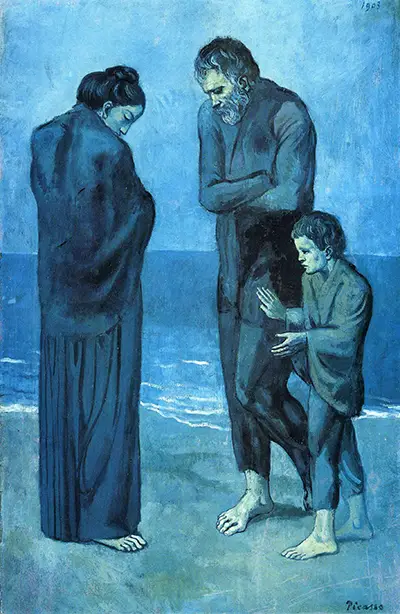There is no sign of disaster on site however the manner in which the adult's figures pose or stands without comforting one another, looking down desperately means all is not well.
The man and woman are looks down inwardly in an innately familiar pose. The child seems too young to understand what is going on looks beseechingly towards the woman.
They seem so distraught to lend any help or respond to the child. Thus the calamity in this painting is subjective rather than in reference to any particular single event. The Tragedy is currently on display at the National Gallery of Art in Washington DC.
Picasso chose to depict forms of human loss and suffering in this painting. He chose to emulate nature in The Tragedy. Decent art resonates with our own human nature and the world in general. Moreover, it points out our personal weakness, personal failure and moral evil without shying away. Nevertheless, Picasso seems to escape from common art pitfalls, for example, lack of art honesty, insufficient naturalism or humanism or the intentional focus on horridness.
Picasso’s Tragedy work of art is inherently unappealing. There is nothing good seeing other people suffering, it’s repulsive! Nonetheless, there is something instinctively beautiful about the Picasso’s Tragedy that is seemingly absurd on the second thought. The Picasso’s work of art takes us to Picasso's grey-blue beach which draws us closer to the unnamed tragedies and the figures involved. It quickly dawns on you how bizarre it is to be enticed by something so dreadful.
Picasso portrays human experience and suffering in such a way that we don’t feel disgusted, no distraction from the human suffering before you. Picasso draws us to the pain itself without distracting us from its attractiveness. The Tragedy attractiveness is beyond that of a pleasant scenery. Tragedy resonates with us by evoking real empathy.
Picasso wasn’t a religious man hence there is no hint of a theological agenda. His parents were neither religious and yet his work seems to have greater agenda. What we can speculate is that perhaps his cultural Catholicism from native Spain instilled cultural honesty.
No matter what kind of tragedy, it cannot compel someone from seeking good. A tragedy is survivable even though God alone can’t overturn the effects of tragedy.
Picasso would have anticipated that tragedy would be viewed from the faith dimension, the supernatural belief overrides our natural empathy and one longs to speak the word of Christ to those three people on the beach. “come to me and you shall all be uplifted,” “I feed all the birds in the air, imagine what I could do for you.”
The artwork has deep blue colours which became famous during the Picasso blue period. It started after a friend to Picasso committed suicide. After careful examination from a studio, it became quite clear that another picture was in the works. The infrared reflectography showed pictures and lettering drawn directly on the wood. It showed outstretched faces similar to 1899 Pablo Picassos drawings. Thus this implied that the panel used in The Tragedy painting was in the studio for about four years.
Visual evidence - The visual clues include evidence of changes to The Tragedy or another picture beneath, there lies a very thickly laid paint that cuts across the man’s right arm bearing nor relations to the hanging of his garment.
Secondly, orange and yellow tones appear in the painting that doesn’t have a relationship with the dark blue colour of the final painting.
Advanced technology evidence - The painting showed a horse and a bullfighting ring which is typical of 1901 Picassos bullfighting paintings.
Some of the bright blue paint from the picture underneath comes out through The Tragedy’s dark blue paint. Further discovery showed a drawing of a horse strutting, a little figure and legs. Thus the panel was in use more than 4 times, hence this signified that he didn’t have sufficient funds.
Many artists would scratch the panel to start over. However, Picasso didn’t scrape the panel instead he would sketch another painting on top of it. Hence this signified that the pictures beneath inspired him to sketch another picture on top. Therefore he would leave clues that the other pictures existed on the same panel.

